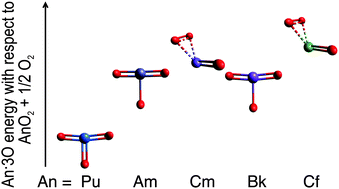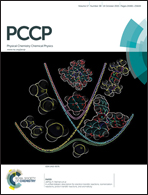Plutonium and transplutonium element trioxides: molecular structures, chemical bonding, and isomers†
Abstract
Ground-state equilibrium geometries, energetics, and vibrational frequencies of AnO3 molecules, An = Pu through Cf, and their isomers are calculated using an accurate small-core pseudopotential model and the two-component relativistic density functional theory. The qualitative features of chemical bonding in these molecules are discussed in terms of oxidation states and bond orders. The actinide oxidation state (VI) is reached only in the plutonium trioxide molecule, whereas heavier actinide atoms in T-shaped trioxide molecules should be considered as pentavalent. At least at low temperatures, PuO3 and, to a lesser degree, AmO3 and BkO3 molecules should be stable both with respect to the isomerization into oxoperoxides or oxosuperoxides and the decay into dioxides and molecular oxygen. These trioxides can form dimers with significant (above 250 kJ mol−1) dissociation energies; the oxidation states of actinide atoms in the lowest-energy configurations of these dimers coincide with those in the corresponding monomers. The ability to reach high oxidation states in oxygen compounds gradually decreases from Pu onwards, with the only exception being the unexpectedly stable Bk(V)O3.


 Please wait while we load your content...
Please wait while we load your content...